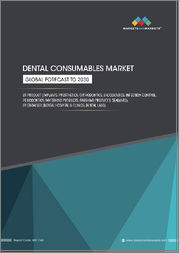
|
시장보고서
상품코드
1577184
치과교정용 브레이스 시장 예측(-2030년) : 유형별, 연령층별, 용도별, 최종사용자별, 지역별 세계 분석Orthodontic Braces Market Forecasts to 2030 - Global Analysis By Type (Metal Braces, Ceramic Braces, Lingual Braces and Clear Aligners), Age Group (Adults, Adolescents and Children), Application, End User and By Geography |
||||||
Stratistics MRC에 따르면 세계의 치과교정용 브레이스 시장은 2024년에 13억 9,000만 달러를 차지하며 2030년에는 21억 7,000만 달러에 달할 것으로 예측되며, 예측 기간 중 CAGR은 7.6%로 성장할 전망입니다.
치과교정용 브레이스는 어긋난 치아와 턱을 정렬하여 기능과 외모를 개선하는 치과용 장비입니다. 교정기는 치아에 고정하는 브래킷과 시간이 지남에 따라 치아를 올바른 위치로 이동시키기 위해 가벼운 압력을 가하는 와이어로 구성됩니다. 금속, 세라믹, 투명 교정기 등 다양한 형태의 교정기는 성인부터 청소년까지 다양한 연령층이 착용하고 있습니다. 치료 기간은 환자의 필요에 따라 다르지만 보통 몇 개월에서 몇년정도 소요됩니다.
미국교정치과의사협회(AAO)에 따르면 미국에는 약 4억 명이 교정치료를 받고 있으며, 그 중 25%가 성인입니다.
치과 건강에 대한 인식 증가
치아 건강에 대한 인식이 높아지면서 치아교정 시장이 크게 성장하고 있습니다. 구강 위생과 심미성의 중요성에 대한 인식이 높아짐에 따라 교정 치료를 찾는 사람들이 증가하고 있습니다. 소셜미디어와 디지털 플랫폼은 심미적인 이유뿐만 아니라 전반적인 구강 건강을 위해 치아 교정의 이점을 대중에게 알리는 데 중요한 역할을 하고 있습니다. 이러한 인식 증가로 인해 교정치료에 대한 수요가 급증하고 있으며, 특히 그동안 교정 치료를 간과했던 성인들 사이에서 수요가 급증하고 있습니다.
고가의 치료비
많은 잠재적 환자들은 교정 및 기타 교정 장비에 필요한 많은 금전적 투자로 인해 주저하는 경우가 많습니다. 치료 기간이 길고 수년간 진행되는 경우가 많기 때문에 전체 비용도 많이 듭니다. 많은 국가에서 치아교정은 심미적인 치료로 간주되어 기본 건강 보험에서 보장되지 않기 때문에 모든 재정적 부담은 환자가 부담해야 합니다. 이러한 비용 장벽은 특히 저소득층과 신흥 국가에 영향을 미쳐 시장 성장을 제한하고 있습니다.
노령인구 증가
전 세계에서 평균 수명이 길어짐에 따라 교정 치료를 포함한 치과 치료를 원하는 노년층이 증가하고 있습니다. 이 계층은 가처분 소득이 많은 경우가 많으며, 구강 건강과 외모 유지에 대한 관심이 점점 더 높아지고 있습니다. 교정 기술의 발전으로 치료가 더욱 편안하고 눈에 띄지 않게 되어 기존 교정 치료를 주저하던 고령의 환자들에게도 매력적입니다. 또한 구강 건강과 전신 건강의 연관성으로 인해 점점 더 많은 노인들이 오랜 치아 문제를 해결하기 위해 교정 치과 치료를 받고 있습니다. 이러한 추세는 치과교정 서비스 프로바이더에게 새롭고 잠재적으로 유리한 시장 부문을 열어줄 수 있습니다.
대체치과 치료의 부상
치과 기술 혁신은 보다 심미적이고 편리한 치아 교정을 제공하는 투명 교정기 등 전통적인 치아 교정을 대체할 수 있는 다양한 대안의 개발로 이어졌습니다. 이러한 대체 치료는 눈에 잘 띄지 않는 교정을 선호하는 성인이나 전문가에게 어필하는 경우가 많습니다. 또한 베니어 및 본딩과 같은 미용 치과의 발전은 미소의 심미성을 개선하기 위한 빠른 솔루션을 제공하여 환자가 장기적인 교정 치료에서 벗어날 수 있도록 합니다. 이러한 대체 수단의 인기가 높아짐에 따라 전통적인 치과교정 시장 점유율이 감소할 수 있으며, 이는 치과교정 치과에 도전이 되고 있습니다.
COVID-19의 영향 :
COVID-19 팬데믹은 처음에는 치과교정용 브레이스 시장을 혼란에 빠뜨렸고, 많은 치과가 휴업 기간 중 문을 닫거나 서비스를 제한했습니다. 그러나 시장은 회복력과 적응력을 보여주었습니다. 텔레덴티스트리와 원격 모니터링 기술이 널리 보급되어 환자 치료를 계속할 수 있게 되었습니다. 폐쇄 후 수요가 급증했는데, 그 중 하나는 화상 통화를 통해 자신의 외모를 의식하게된 '줌 효과'로 인해 수요가 급증했기 때문입니다. 전염병은 또한 디지털 교정 솔루션과 비접촉식 치료의 채택을 가속화했습니다.
투명교정 부문이 예측 기간 중 가장 큰 비중을 차지할 것으로 예상됩니다.
예측 기간 중 투명교정 부문이 시장 점유율을 독식할 것으로 예상됩니다. 이러한 우위는 심미적으로 아름답고 눈에 잘 띄지 않는 교정 치료에 대한 선호도가 높아졌기 때문입니다. 투명교정는 향상된 편안함, 구강 위생 유지의 용이성, 식사나 특별한 날을 위해 제거할 수 있는 등의 이점을 제공합니다. 이 부문의 성장은 3D 프린팅과 디지털 스캐닝의 기술 발전으로 인해 더욱 촉진되어 투명교정의 정확성과 사용자 정의가 향상되어 시장에서 이 부문의 선도적 인 위치에 기여하고 있습니다.
예측 기간 중 성인 부문이 가장 높은 CAGR을 나타낼 것으로 예상됩니다.
예측 기간 중 성인 부문은 가장 높은 CAGR로 성장할 것으로 예상됩니다. 이러한 빠른 성장의 배경에는 성인의 치과 미용에 대한 인식 증가, 가처분 소득 증가, 투명 교정기 및 설측 교정과 같은 눈에 잘 띄지 않는 교정 옵션의 가용성 등 여러 가지 요인이 있습니다. 성인들은 직장에서의 외모를 개선하고 자신감을 높이기 위해 교정 치료를 받고자 하는 경향이 있습니다. 이 부문의 성장은 치료 기간과 불편함에 대한 성인 환자의 우려를 해결하고 치료를 더 빠르고 편안하게 만드는 교정 기술의 발전으로 지원되고 있습니다.
가장 큰 점유율을 차지하는 지역 :
예측 기간 중 북미가 가장 큰 시장 점유율을 차지할 것으로 예상됩니다. 이러한 우위는 치과 미용에 대한 높은 인식, 잘 구축된 의료 인프라, 주요 시장 기업의 존재와 같은 요인에 기인합니다. 이 지역은 첨단 교정 기술, 높은 투명교정 채택률, 유리한 환급 정책의 혜택을 누리고 있습니다. 또한 미용 치과에 대한 관심이 높아지고 교정 치료를 원하는 성인 환자가 증가함에 따라 북미가 선도적인 위치를 차지하게 되었습니다.
CAGR이 가장 높은 지역 :
아시아태평양은 예측 기간 중 가장 높은 CAGR을 달성할 것으로 예상됩니다. 이러한 빠른 성장의 배경에는 가처분 소득 증가, 치과 미용에 대한 인식 증가, 중국 및 인도와 같은 신흥 경제국의 의료 인프라 개선 등의 요인이 있습니다. 이 지역에서는 특히 젊은 층을 중심으로 교정치료에 대한 수요가 증가하고 있습니다. 또한 첨단 교정 기술의 채택 증가와 국제적인 업체들의 이 지역 시장 진출은 아시아태평양의 높은 성장률을 촉진할 것으로 예상됩니다.
무료 커스터마이징 제공:
이 보고서를 구독하는 고객은 다음과 같은 무료 맞춤화 옵션 중 하나를 사용할 수 있습니다. :
- 기업 개요
- 추가 시장 기업의 종합적인 프로파일링(최대 3사)
- 주요 기업의 SWOT 분석(최대 3사)
- 지역 세분화
- 고객의 관심에 따른 주요 국가별 시장 추정치, 예측, CAGR(주: 타당성 확인에 따라 다름)
- 경쟁사 벤치마킹
- 제품 포트폴리오, 지역적 입지, 전략적 제휴를 기반으로 한 주요 기업의 벤치마킹
목차
제1장 개요
제2장 서문
- 개요
- 이해관계자
- 조사 범위
- 조사 방법
- 데이터 마이닝
- 데이터 분석
- 데이터 검증
- 조사 어프로치
- 조사 정보원
- 1차 조사 정보원
- 2차 조사 정보원
- 전제조건
제3장 시장 동향 분석
- 촉진요인
- 억제요인
- 기회
- 위협
- 용도 분석
- 최종사용자 분석
- 신흥 시장
- COVID-19의 영향
제4장 Porter's Five Forces 분석
- 공급 기업의 교섭력
- 바이어의 교섭력
- 대체품의 위협
- 신규 진출업체의 위협
- 경쟁 기업 간 경쟁 관계
제5장 세계의 치과교정용 브레이스 시장 : 유형별
- 금속 브레이스
- 기존 금속 브레이스
- Self-Ligating 브레이스
- 세라믹 브레이스
- 투명 세라믹 브레이스
- 다결정 세라믹 브레이스
- 설측 브레이스
- 투명교정
제6장 세계의 치과교정용 브레이스 시장 : 연령층별
- 성인
- 청소년
- 어린이
제7장 세계의 치과교정용 브레이스 시장 : 용도별
- 부정교합 치료
- 클래스 I
- 클래스 II
- 클래스 III
- Crowding
- Spacing
- Crossbite
- Open Bite
- Deep Bite
제8장 세계의 치과교정용 브레이스 시장 : 최종사용자별
- 치과의원
- 병원
- 교정 치과 센터
- 치과 학술연구기관
제9장 세계의 치과교정용 브레이스 시장 : 지역별
- 북미
- 미국
- 캐나다
- 멕시코
- 유럽
- 독일
- 영국
- 이탈리아
- 프랑스
- 스페인
- 기타 유럽
- 아시아태평양
- 일본
- 중국
- 인도
- 호주
- 뉴질랜드
- 한국
- 기타 아시아태평양
- 남미
- 아르헨티나
- 브라질
- 칠레
- 기타 남미
- 중동 및 아프리카
- 사우디아라비아
- 아랍에미리트
- 카타르
- 남아프리카공화국
- 기타 중동 및 아프리카
제10장 주요 발전
- 계약, 파트너십, 협업, 합병사업
- 인수와 합병
- 신제품 발매
- 사업 확대
- 기타 주요 전략
제11장 기업 프로파일링
- Align Technology Inc.
- 3M Company
- Dentsply Sirona Inc.
- Henry Schein, Inc.
- Envista Holdings Corporation
- Institut Straumann AG
- American Orthodontics
- DENTAURUM GmbH & Co. KG
- TP Orthodontics, Inc.
- G&H Orthodontics
- Rocky Mountain Orthodontics
- DB Orthodontics Limited
- Great Lakes Dental Technologies
- Ultradent Products, Inc.
- Morelli Ortodontia
- JJ Orthodontics
- Sino Ortho Limited
- JISCOP Co., Ltd.
According to Stratistics MRC, the Global Orthodontic Braces Market is accounted for $1.39 billion in 2024 and is expected to reach $2.17 billion by 2030, growing at a CAGR of 7.6% during the forecast period. Orthodontic braces are dental appliances that improve function and appearance by realigning misaligned teeth and jaws. They are made up of brackets that are affixed to the teeth and wires that, over time, apply light pressure to move the teeth into their proper positions. Braces, which come in a variety of forms such as metal, ceramic, and clear aligners, are frequently worn by adults and teenagers. Depending on each patient's needs, the length of treatment varies but usually lasts several months to a few years.
According to the American Association of Orthodontists (AAO), nearly 4 million people in the United States are wearing braces, with 25% of them being adults.
Market Dynamics:
Driver:
Increasing awareness of dental health
The growing awareness of dental health is significantly driving the orthodontic braces market. As people become more conscious of the importance of oral hygiene and aesthetics, they are increasingly seeking orthodontic treatments. Social media and digital platforms have played a crucial role in educating the public about the benefits of straight teeth, not just for cosmetic reasons but also for overall oral health. This heightened awareness has led to a surge in demand for orthodontic services, particularly among adults who may have previously overlooked such treatments.
Restraint:
High treatment costs
Many potential patients are deterred by the substantial financial investment required for braces and other orthodontic appliances. The extended duration of treatments, often spanning several years, adds to the overall expense. In many countries, orthodontic procedures are considered cosmetic and are not covered by basic health insurance plans, placing the financial burden entirely on the patient. This cost barrier particularly affects lower-income populations and developing countries, limiting market growth..
Opportunity:
Growing geriatric population
As life expectancy increases globally, there is a larger pool of older adults seeking dental care, including orthodontic treatments. This demographic often has more disposable income and is increasingly concerned about maintaining their oral health and appearance. Advances in orthodontic technology have made treatments more comfortable and less noticeable, appealing to older patients who might have been hesitant about traditional braces. Additionally, the link between oral health and overall well-being is driving more seniors to seek orthodontic care to address long-standing dental issues. This trend opens up a new and potentially lucrative market segment for orthodontic providers.
Threat:
Rise of alternative dental treatments
Innovations in dentistry have led to the development of various alternatives to conventional braces, such as clear aligners, which offer a more aesthetic and convenient option for teeth straightening. These alternatives often appeal to adults and professionals who prefer less visible orthodontic solutions. Additionally, advancements in cosmetic dentistry, like veneers and bonding, provide quicker solutions for improving smile aesthetics, potentially diverting patients from longer-term orthodontic treatments. The growing popularity of these alternatives could potentially reduce the market share of traditional braces, challenging orthodontic practices.
Covid-19 Impact:
The COVID-19 pandemic initially disrupted the orthodontic braces market, with many dental practices closing or limiting services during lockdowns. However, the market showed resilience and adaptation. Teledentistry and remote monitoring technologies gained traction, allowing for continued patient care. Post-lockdown, there was a surge in demand, partly attributed to the "Zoom effect" as people became more aware of their appearance in video calls. The pandemic also accelerated the adoption of digital orthodontic solutions and contactless treatments.
The clear aligners segment is expected to be the largest during the forecast period
Over the forecasted timeframe, the clear aligners segment is anticipated to dominate the market share. This dominance is attributed to the increasing preference for aesthetically pleasing and less noticeable orthodontic treatments. Clear aligners offer advantages such as improved comfort, easier maintenance of oral hygiene, and the ability to remove them for eating and special occasions. The segment's growth is further fueled by technological advancements in 3D printing and digital scanning, which have enhanced the precision and customization of clear aligners, contributing to the segment's leading position in the market.
The adults segment is expected to have the highest CAGR during the forecast period
During the projection period, the adults segment is expected to grow at the highest CAGR. This rapid growth is driven by several factors, including increased awareness of dental aesthetics among adults, rising disposable incomes, and the availability of more discreet orthodontic options like clear aligners and lingual braces. Adults are increasingly seeking orthodontic treatments to improve their professional appearance and boost self-confidence. The segment's growth is also supported by advancements in orthodontic technology that have made treatments faster and more comfortable, addressing the concerns of adult patients about treatment duration and discomfort.
Region with largest share:
During the estimation period, the North America region is expected to capture the largest market share. This dominance is attributed to factors such as high awareness of dental aesthetics, well-established healthcare infrastructure, and the presence of major market players. The region benefits from advanced orthodontic technologies, a high adoption rate of clear aligners, and favorable reimbursement policies. Additionally, the increasing focus on cosmetic dentistry and the growing adult patient population seeking orthodontic treatments contribute to North America's leading position.
Region with highest CAGR:
The Asia Pacific region is projected to achieve the highest CAGR during the forecast period. This rapid growth is driven by factors such as increasing disposable incomes, growing awareness of dental aesthetics, and improving healthcare infrastructure in emerging economies like China and India. The region is witnessing a rising demand for orthodontic treatments, particularly among the young adult population. Additionally, the increasing adoption of advanced orthodontic technologies and the entry of international players into the regional market are expected to fuel the high growth rate in Asia Pacific.
Key players in the market
Some of the key players in Orthodontic Braces Market include Align Technology Inc., 3M Company, Dentsply Sirona Inc., Henry Schein, Inc., Envista Holdings Corporation, Institut Straumann AG, American Orthodontics, DENTAURUM GmbH & Co. KG, TP Orthodontics, Inc., G&H Orthodontics, Rocky Mountain Orthodontics, DB Orthodontics Limited, Great Lakes Dental Technologies, Ultradent Products, Inc., Morelli Ortodontia, JJ Orthodontics, Sino Ortho Limited, and JISCOP Co., Ltd.
Key Developments:
In April 2024, Align Technology Inc. launched the Invisalign Palatal Expander System in Australia and New Zealand, expanding their orthodontic product offerings.
In April 2024, 3M Company announced the spin-off of its health care business, including its orthodontics division, into a new company called Solventum.
Types Covered:
- Metal Braces
- Ceramic Braces
- Lingual Braces
- Clear Aligners
Age Groups Covered:
- Adults
- Adolescents
- Children
Applications Covered:
- Malocclusion Treatment
- Crowding
- Spacing
- Crossbite
- Open Bite
- Deep Bite
End Users Covered:
- Dental Clinics
- Hospitals
- Orthodontic Centers
- Dental Academic & Research Institutes
Regions Covered:
- North America
- US
- Canada
- Mexico
- Europe
- Germany
- UK
- Italy
- France
- Spain
- Rest of Europe
- Asia Pacific
- Japan
- China
- India
- Australia
- New Zealand
- South Korea
- Rest of Asia Pacific
- South America
- Argentina
- Brazil
- Chile
- Rest of South America
- Middle East & Africa
- Saudi Arabia
- UAE
- Qatar
- South Africa
- Rest of Middle East & Africa
What our report offers:
- Market share assessments for the regional and country-level segments
- Strategic recommendations for the new entrants
- Covers Market data for the years 2022, 2023, 2024, 2026, and 2030
- Market Trends (Drivers, Constraints, Opportunities, Threats, Challenges, Investment Opportunities, and recommendations)
- Strategic recommendations in key business segments based on the market estimations
- Competitive landscaping mapping the key common trends
- Company profiling with detailed strategies, financials, and recent developments
- Supply chain trends mapping the latest technological advancements
Free Customization Offerings:
All the customers of this report will be entitled to receive one of the following free customization options:
- Company Profiling
- Comprehensive profiling of additional market players (up to 3)
- SWOT Analysis of key players (up to 3)
- Regional Segmentation
- Market estimations, Forecasts and CAGR of any prominent country as per the client's interest (Note: Depends on feasibility check)
- Competitive Benchmarking
- Benchmarking of key players based on product portfolio, geographical presence, and strategic alliances
Table of Contents
1 Executive Summary
2 Preface
- 2.1 Abstract
- 2.2 Stake Holders
- 2.3 Research Scope
- 2.4 Research Methodology
- 2.4.1 Data Mining
- 2.4.2 Data Analysis
- 2.4.3 Data Validation
- 2.4.4 Research Approach
- 2.5 Research Sources
- 2.5.1 Primary Research Sources
- 2.5.2 Secondary Research Sources
- 2.5.3 Assumptions
3 Market Trend Analysis
- 3.1 Introduction
- 3.2 Drivers
- 3.3 Restraints
- 3.4 Opportunities
- 3.5 Threats
- 3.6 Application Analysis
- 3.7 End User Analysis
- 3.8 Emerging Markets
- 3.9 Impact of Covid-19
4 Porters Five Force Analysis
- 4.1 Bargaining power of suppliers
- 4.2 Bargaining power of buyers
- 4.3 Threat of substitutes
- 4.4 Threat of new entrants
- 4.5 Competitive rivalry
5 Global Orthodontic Braces Market, By Type
- 5.1 Introduction
- 5.2 Metal Braces
- 5.2.1 Traditional Metal Braces
- 5.2.2 Self-Ligating Braces
- 5.3 Ceramic Braces
- 5.3.1 Clear Ceramic Braces
- 5.3.2 Polycrystalline Ceramic Braces
- 5.4 Lingual Braces
- 5.5 Clear Aligners
6 Global Orthodontic Braces Market, By Age Group
- 6.1 Introduction
- 6.2 Adults
- 6.3 Adolescents
- 6.4 Children
7 Global Orthodontic Braces Market, By Application
- 7.1 Introduction
- 7.2 Malocclusion Treatment
- 7.2.1 Class I
- 7.2.2 Class II
- 7.2.3 Class III
- 7.3 Crowding
- 7.4 Spacing
- 7.5 Crossbite
- 7.6 Open Bite
- 7.7 Deep Bite
8 Global Orthodontic Braces Market, By End User
- 8.1 Introduction
- 8.2 Dental Clinics
- 8.3 Hospitals
- 8.4 Orthodontic Centers
- 8.5 Dental Academic & Research Institutes
9 Global Orthodontic Braces Market, By Geography
- 9.1 Introduction
- 9.2 North America
- 9.2.1 US
- 9.2.2 Canada
- 9.2.3 Mexico
- 9.3 Europe
- 9.3.1 Germany
- 9.3.2 UK
- 9.3.3 Italy
- 9.3.4 France
- 9.3.5 Spain
- 9.3.6 Rest of Europe
- 9.4 Asia Pacific
- 9.4.1 Japan
- 9.4.2 China
- 9.4.3 India
- 9.4.4 Australia
- 9.4.5 New Zealand
- 9.4.6 South Korea
- 9.4.7 Rest of Asia Pacific
- 9.5 South America
- 9.5.1 Argentina
- 9.5.2 Brazil
- 9.5.3 Chile
- 9.5.4 Rest of South America
- 9.6 Middle East & Africa
- 9.6.1 Saudi Arabia
- 9.6.2 UAE
- 9.6.3 Qatar
- 9.6.4 South Africa
- 9.6.5 Rest of Middle East & Africa
10 Key Developments
- 10.1 Agreements, Partnerships, Collaborations and Joint Ventures
- 10.2 Acquisitions & Mergers
- 10.3 New Product Launch
- 10.4 Expansions
- 10.5 Other Key Strategies
11 Company Profiling
- 11.1 Align Technology Inc.
- 11.2 3M Company
- 11.3 Dentsply Sirona Inc.
- 11.4 Henry Schein, Inc.
- 11.5 Envista Holdings Corporation
- 11.6 Institut Straumann AG
- 11.7 American Orthodontics
- 11.8 DENTAURUM GmbH & Co. KG
- 11.9 TP Orthodontics, Inc.
- 11.10 G&H Orthodontics
- 11.11 Rocky Mountain Orthodontics
- 11.12 DB Orthodontics Limited
- 11.13 Great Lakes Dental Technologies
- 11.14 Ultradent Products, Inc.
- 11.15 Morelli Ortodontia
- 11.16 JJ Orthodontics
- 11.17 Sino Ortho Limited
- 11.18 JISCOP Co., Ltd.



















